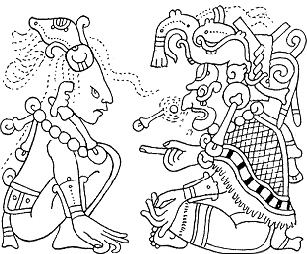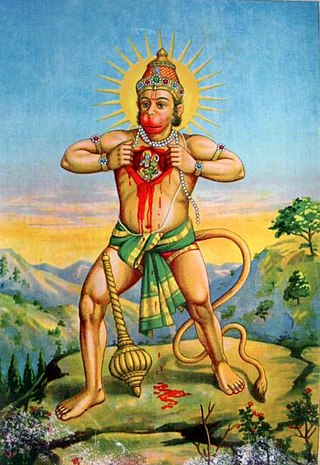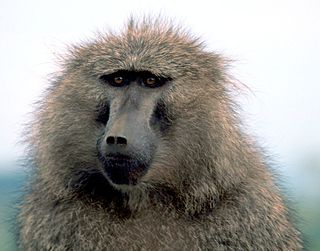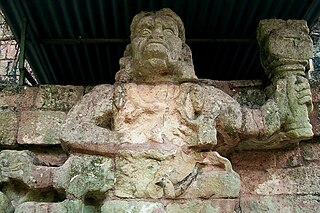
Primates are a diverse order of mammals. They are divided into the strepsirrhines, which include the lemurs, galagos, and lorisids, and the haplorhines, which include the tarsiers and the simians. Primates arose 85–55 million years ago first from small terrestrial mammals, which adapted to living in the trees of tropical forests: many primate characteristics represent adaptations to life in this challenging environment, including large brains, visual acuity, color vision, a shoulder girdle allowing a large degree of movement in the shoulder joint, and dextrous hands. Primates range in size from Madame Berthe's mouse lemur, which weighs 30 g (1 oz), to the eastern gorilla, weighing over 200 kg (440 lb). There are 376–524 species of living primates, depending on which classification is used. New primate species continue to be discovered: over 25 species were described in the 2000s, 36 in the 2010s, and three in the 2020s.

Mayan or Maya mythology is part of Mesoamerican mythology and comprises all of the Maya tales in which personified forces of nature, deities, and the heroes interacting with these play the main roles. The myths of the era have to be reconstructed from iconography. Other parts of Mayan oral tradition are not considered here.

Hanuman, also called Maruti, Bajrangabali, and Anjaneya, is a Hindu god and a divine vanara companion of the god Rama. Hanuman is one of the central characters of the Hindu epic Ramayana. He is an ardent devotee of Rama and one of the chiranjivis. Hanuman is regarded to be the spiritual son of the wind-god Vayu, who in several stories played a direct role in Hanuman's birth. Hanuman is mentioned in several other texts, such as the epic Mahabharata and the various Puranas.

Primatology is the scientific study of primates. It is a diverse discipline at the boundary between mammalogy and anthropology, and researchers can be found in academic departments of anatomy, anthropology, biology, medicine, psychology, veterinary sciences and zoology, as well as in animal sanctuaries, biomedical research facilities, museums and zoos. Primatologists study both living and extinct primates in their natural habitats and in laboratories by conducting field studies and experiments in order to understand aspects of their evolution and behavior.

In Hinduism, Vanara are either monkeys, apes, or a race of forest-dwelling people.

Sugriva is a character In the ancient Indian epic Ramayana. He is the younger brother of Vali, whom he succeeded as ruler of the vanara kingdom of Kishkindha. Rumā is his wife. He is a son of Surya, the Hindu deity of the sun. As the king of the vanaras, Sugriva aided Rama in his quest to liberate his wife Sita from captivity at the hands of the rakshasa king Ravana.

Howler monkeys are the most widespread primate genus in the Neotropics and are among the largest of the platyrrhines along with the muriquis (Brachyteles), the spider monkeys (Ateles) and woolly monkeys (Lagotrix). The monkeys are native to South and Central American forests. They are famous for their loud howls, which can be heard up to three miles away through dense rain forest. Fifteen species are recognized. Previously classified in the family Cebidae, they are now placed in the family Atelidae. They are primarily folivores but also significant frugivores, acting as seed dispersal agents through their digestive system and their locomotion. Threats include human predation, habitat destruction, illegal wildlife trade, and capture for pets or zoo animals.

Reamker is a Cambodian epic poem, based on the Sanskrit's Rāmāyana epic. The name means "Glory of Rama". It is the national epic of Cambodia. The earliest mention of this epic's manuscript in Cambodia dates back to the 7th century based on Veal Kantel inscription (K.359). The surviving text of Reamker dates from 16th century. Reamker adapts the Hindu ideas of the Ramayana to Buddhist themes and shows the balance of good and evil in the world. More than just a reordering of the epic tale, the Reamker is a mainstay of the royal ballet's repertoire. Like the Ramayana, it is a philosophical allegory, exploring the ideals of justice and fidelity as embodied by the protagonists, King Rāma and Queen Sītā. The epic is well known among the Khmer people for its portrayal in Khmer dance theatre, called the Lakhon, in various festivals across Cambodia. Scenes from the Reamker are painted on the walls of the Royal Palace in Khmer style, and its predecessor is carved into the walls of the Angkor Wat and Banteay Srei temples. It is considered an integral part of Cambodian culture.

Ramcharitmanas, is an epic poem (Mahakavya) in the Awadhi language, based on the Ramayana, and composed by the 16th-century Indian bhakti poet Tulsidas. This work is also called, in popular parlance, Tulsi Ramayana, Tulsikrit Ramayana, Tulsidas Ramayana or simply Manas. The word Ramcharitmanas literally means "Lake of the deeds of Rama". It is considered one of the greatest works of Hindu literature. The work has variously been acclaimed as "the living sum of Indian culture", "the tallest tree in the magic garden of medieval Indian poetry", "the greatest book of all devotional literature" and "the best and most trustworthy guide to the popular living faith of the Indian people".

Mpinguari, or Mpinguary, are mythical monstrous jungle-dwelling spirits from Brazilian folklore said to protect the forest and its animals.

Monkey is a common name that may refer to most mammals of the infraorder Simiiformes, also known as the simians. Traditionally, all animals in the group now known as simians are counted as monkeys except the apes, which constitutes an incomplete paraphyletic grouping; however, in the broader sense based on cladistics, apes (Hominoidea) are also included, making the terms monkeys and simians synonyms in regard to their scope.

The black howler or black-and-gold howler, is among the largest New World monkeys and a member of the Alouatta genus. The black howler is distributed in areas of South America such as Paraguay, southern Brazil, eastern Bolivia, northern Argentina, and Uruguay. This species is sexually dimorphic, with adult males having entirely black fur and adult females and babies of both sexes having an overall golden colouring; which emphasizes black-and-gold in the name. The IUCN Red List has classed the black howler as Near Threatened as a result of a recent population reduction due to a variety of human-caused factors.
Linda Marie Fedigan, is a professor and Canada Research Chair in Primatology and Bioanthropology at the University of Calgary, Alberta. In addition, Fedigan is also the Executive Editor of the American Journal of Primatology and a fellow of the Royal Society of Canada. Prior to accepting her current position, Dr. Fedigan was a professor at the University of Alberta, teaching anthropology from 1974 until 2001. She is internationally recognized for over 30 years of contribution to the study of primate life history, reproduction, socioecology and conservation and is considered a major authority on the life history and reproductive patterns of female primates.

Among the Classic Mayas, the howler monkey god was a major deity of the arts—including music—and a patron of the artisans, especially of the scribes and sculptors. As such, his sphere of influence overlapped with that of the Tonsured Maize God. The monkey patrons—there are often two of them—have been depicted on classical vases in the act of writing books and carving human heads. Together, these two activities may have constituted a metaphor for the creation of mankind, with the book containing the birth signs and the head the life principle or 'soul', an interpretation reinforced by the craftsman titles of the creator gods in the Popol Vuh.

In the Hindu epic Ramayana, Tara is the Queen of Kishkindha and the wife of the monkey (vanara) King Vali. After being widowed, she becomes the Queen of Sugriva, Vali's younger brother.
Alejandro Estrada is a primatologist and the author and editor of several books and articles about primates. He is a research scientist at the field research station Los Tuxtlas of Universidad Nacional Autonoma de Mexico He was the founder and executive editor of Tropical Conservation Science. Books he has authored or edited include New Perspectives in the Study of Mesoamerican Primates: Distribution, Ecology, Behavior, and Conservation, Frugivores and Seed Dispersal: Ecological and Evolutionary Aspects , Las Selvas Tropicales Humedas de Mexico: Recurso Poderoso pero Vulnerable and Comportamiento Animal: el Caso de los Primates.

Agustín Fuentes is an American primatologist and biological anthropologist at Princeton University and formerly the chair of the Department of Anthropology at the University of Notre Dame. His work focuses largely on human and non-human primate interaction, pathogen transfer, communication, cooperation, and human social evolution.

The Maya death gods known by a variety of names, are two basic types of death gods who are respectively represented by the 16th-century Yucatec deities Hunhau and Uacmitun Ahau mentioned by Spanish Bishop Landa. Hunhau is the lord of the Underworld. Iconographically, Hunhau and Uacmitun Ahau correspond to the Gods A and A' . In recent narratives, particularly in the oral tradition of the Lacandon people, there is only one death god, who acts as the antipode of the Upper God in the creation of the world and of the human body and soul. This death god inhabits an Underworld that is also the world of the dead. As a ruler over the world of the dead, the principal death god corresponds to the Aztec deity Mictlāntēcutli. The Popol Vuh has two leading death gods, but these two are really one: Both are called "Death," but while one is known as "One Death," the other is called "Seven Death." They were vanquished by the Hero Twins.
Jai Hanuman is a 1997 Indian television series based on the life of the Hindu deity Hanuman, an avatar of Shiva, in Hindi. It was directed by Sanjay Khan. The series was initially shown on the state-run DD National, and was later shown on Sony Entertainment Television in 2008.

Siya Ke Ram is an Indian TV series on Star Plus produced by Nikhil Sinha under the banner of Triangle Film Company. This show presents the epic Ramayana, the story of Rama and Devi Sita from Sita's perspective. The show features Madirakshi Mundle and Ashish Sharma playing as Goddess Sita and Lord Rama, respectively, and Karthik Jayaram as Raavan. It premiered on 16 November 2015 and ended on 4 November 2016.
Wolfe, L.D., and Fuentes, A. (2007) Ethnoprimatology: Contextualizing Human/Primate Interactions in C. Campbell, A. Fuentes. K. MacKinnon, M. Panger and S. Bearder Eds. Primates in Perspective Oxford University Press pp. 691–701














